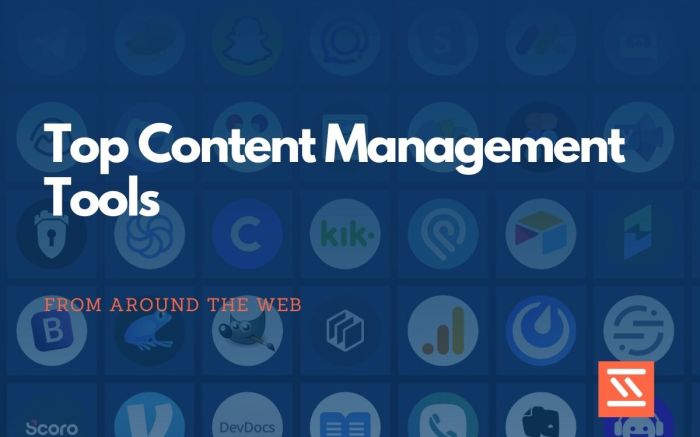Using Content Management Tools revolutionizes the way websites are managed, offering a streamlined approach to content creation and publication. Dive into the world of CMS tools and discover the key to efficient website management.
Introduction to Content Management Tools

Content management tools are software applications that help website owners create, manage, and publish digital content without requiring extensive technical knowledge. These tools provide a user-friendly interface that allows for easy content editing, organization, and distribution.
Using content management tools is crucial for website management as they help streamline the content creation and publishing processes. With these tools, website owners can easily update content, collaborate with team members, schedule posts, and maintain a consistent brand image across all digital platforms.
Popular Content Management Tools
- WordPress: A versatile and user-friendly platform that powers a large percentage of websites on the internet.
- Drupal: An open-source content management system known for its flexibility and scalability.
- Joomla: Another popular CMS that offers a wide range of features and extensions for website customization.
- Wix: A website builder that combines content management tools with drag-and-drop functionality for easy website creation.
These content management tools offer templates, plugins, and integrations that help website owners create engaging content, optimize for search engines, and improve overall user experience.
Types of Content Management Tools

Content management tools come in various types, each serving different purposes and catering to unique needs. Let’s explore the different types of content management tools available in the market.
Traditional CMS vs. Headless CMS
Traditional CMS, such as WordPress, Joomla, and Drupal, are all-in-one solutions that provide a user-friendly interface for creating, managing, and publishing content. On the other hand, headless CMS, like Contentful and Strapi, separate the content from the presentation layer, allowing for more flexibility and scalability in delivering content across various platforms and devices.
Cloud-Based Content Management Tools, Using Content Management Tools
Cloud-based content management tools, such as Sitecore and Kentico Cloud, offer the convenience of accessing and managing content from anywhere with an internet connection. These tools provide scalability, security, and cost-effectiveness, making them a popular choice for businesses of all sizes.
Open-Source vs. Proprietary CMS
Open-source CMS, like WordPress and Drupal, are free to use and customize, with a large community of developers contributing to their development. On the other hand, proprietary CMS, such as Adobe Experience Manager and Sitecore, offer advanced features, dedicated support, and security, but come with a price tag.
AI-Powered Content Management Tools
AI-powered content management tools, like Acrolinx and MarketMuse, leverage artificial intelligence to automate content creation, optimization, and personalization. These tools can analyze data, predict trends, and enhance user experience, revolutionizing the content management industry.
Key Features to Look for in Content Management Tools: Using Content Management Tools
When choosing a content management tool, it’s crucial to consider key features that can make your content creation and management process more efficient and effective.
User-Friendly Interface
A user-friendly interface is essential for seamless navigation and ease of use. Look for CMS platforms that offer intuitive design and simple controls to help you create and manage content without any technical hurdles.
Customization Options and Scalability
The ability to customize your CMS to suit your specific needs and scale as your business grows is vital. Ensure the platform offers flexibility in design, layout, and functionality to accommodate your changing requirements.
Mobile Responsiveness and Optimization
Mobile responsiveness is crucial in today’s mobile-driven world. Choose a CMS that prioritizes responsive design to ensure your content looks great on all devices. Additionally, look for built-in optimization tools to help improve your content’s visibility and ranking in search engines.
Content Workflow Management and Collaboration Tools
Efficient content workflow management is key to ensuring smooth collaboration among team members. Seek CMS platforms that offer workflow automation, task assignment, and version control features to streamline content creation and approval processes.
Analytics and Reporting Tools
Integrating analytics and reporting tools into your CMS can provide valuable insights into your content performance. Look for platforms that offer robust analytics capabilities to track key metrics, such as page views, engagement, and conversions, enabling you to make data-driven decisions to optimize your content strategy.
Best Practices for Using Content Management Tools
When using content management tools, it’s important to follow best practices to ensure efficiency and effectiveness in managing your content. Here are some tips to help you make the most out of your CMS:
Organizing Content Effectively
Organizing your content within the tool is crucial for easy access and management. Create a logical folder structure, use categories and tags appropriately, and establish clear naming conventions for files. This will help you and your team locate content quickly and maintain a streamlined workflow.
Optimizing Metadata and Tags
Make sure to optimize metadata and tags for better searchability. Use relevant s, descriptions, and tags to help users find your content easily. By incorporating best practices into your metadata, you can improve your content’s visibility and reach a wider audience.
Version Control and Content Scheduling
Implement version control to track changes and updates made to your content. This ensures that you can revert to previous versions if needed and maintain an organized content history. Additionally, utilize content scheduling features to plan and automate the publishing of your content, saving you time and ensuring consistency in your posting schedule.
Regular Backups and Security Measures
Regularly backup your content to prevent data loss in case of system failures or cyber attacks. Set up automatic backups or schedule regular manual backups to safeguard your content. Additionally, prioritize security measures such as user permissions, encryption, and software updates to protect your content from unauthorized access and potential breaches.
